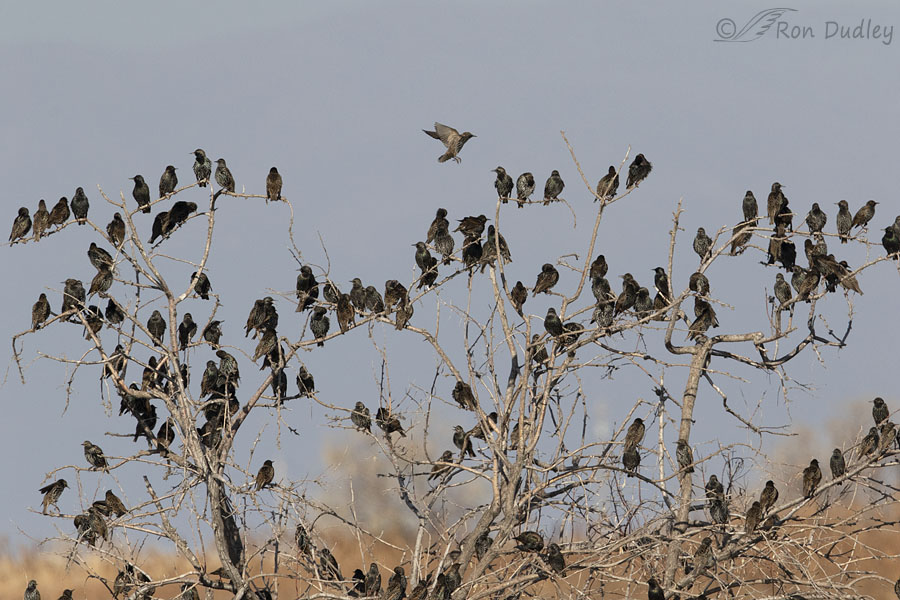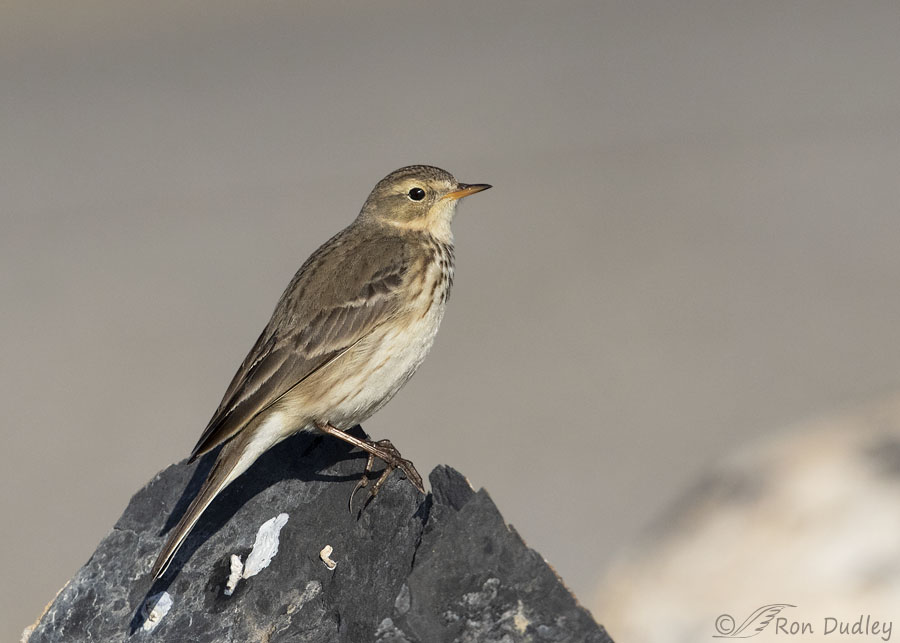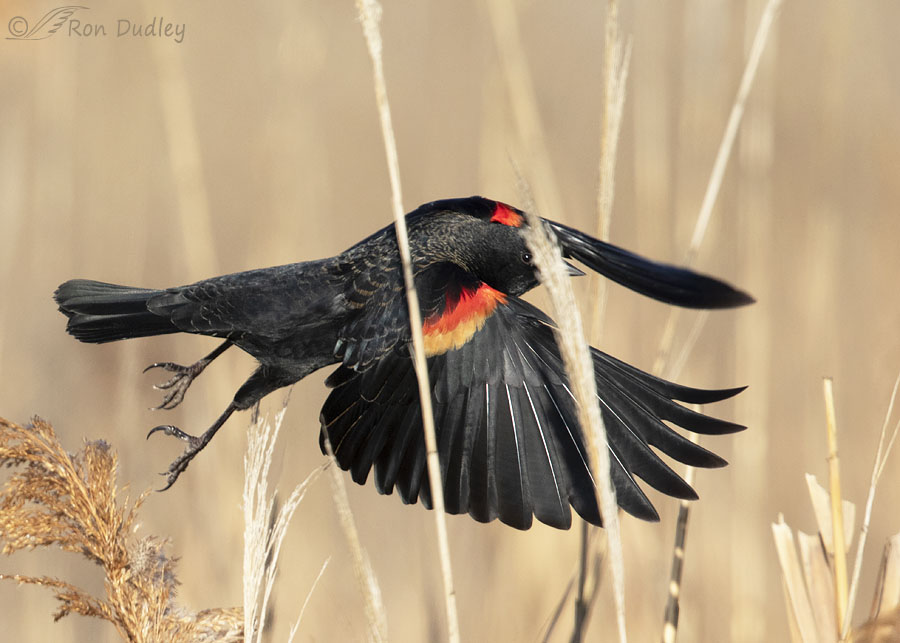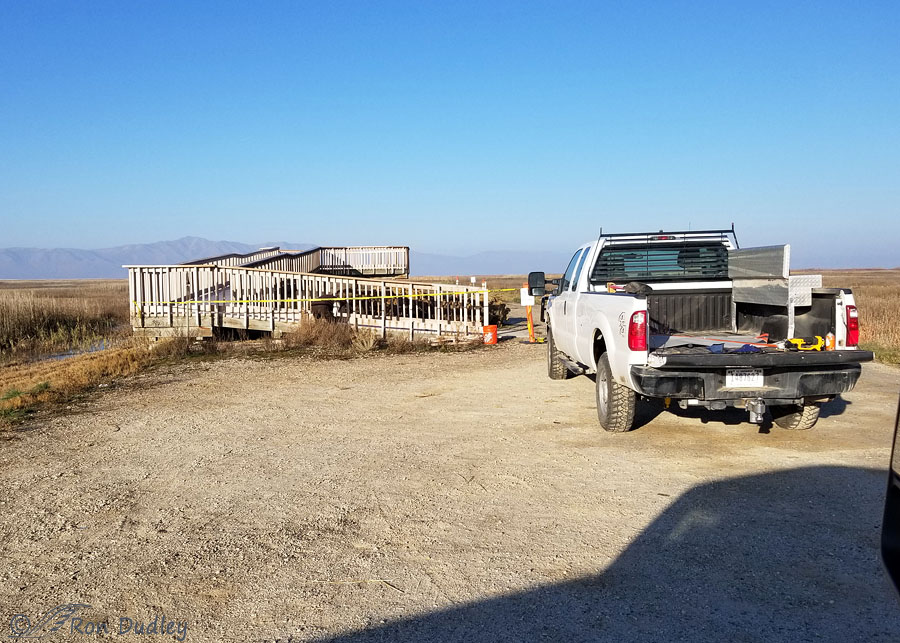I finally found some birds yesterday. And I learned some stuff.

European Starlings were out in force and even though I rarely aim my l lens their way this large flock weighing down a small tree was pretty impressive. Because of their black color and the time of year it reminded me of a Christmas tree in mourning.

1/3200, f/8, ISO 500, Canon 7D Mark II, Canon EF 500mm f/4L IS II USM + EF 1.4 III Extender, not baited, set up or called in
I had a great time with a small group of American Pipits that were scampering around a rock pile. In recent weeks pipits have seemed almost omnipresent in many of my birding haunts but they’ve also been extremely shy and elusive so it was fun to finally find a few cooperative individuals.
Most of the rocks they were on were about the color of the out of focus rock at lower right so I was watching carefully for one of them to land on this black rock. Finally one of them did and I even captured a nice pose in good light.

1/2500, f/6.3, ISO 640, Canon 7D Mark II, Canon EF 500mm f/4L IS II USM + EF 1.4 III Extender, not baited, set up or called in
This is my “almost” shot.
Because of their photon-sucking deep black color, Red-winged Blackbirds are hard enough to photograph well when they’re perched. So to get a flight posture like this with his red and yellow epaulet displayed so well, excellent detail in the blacks of his entire body and to get him sharp without cutting off any body parts is an accomplishment.
So I was deeply disappointed to have it all ruined by the phrag stalks in front of the bird. But the photo shows me what’s possible so I’ll keep trying.

Cell phone photo
Locals will recognize this ancient and decrepit viewing platform near the end of the auto tour route at Bear River MBR. Though it’s rarely used these days it’s been a landmark on the refuge for decades. Yesterday morning I noticed a refuge employee working on it and I suspected it was about to be demolished, just like another viewing platform was fairly recently torn down on the southwest corner of the auto tour loop.
I’m a nosy old soul when it comes to our refuges so I drove down the short spur road to the platform to ask the worker (bent over with his back to us behind the yellow tape) what was going on. He confirmed that the platform is about to be demolished and removed. It was recently inspected by the state and determined to be unsafe, especially if a large group of people (from a tour bus for example) were on it at the same time.
I can understand why it has to go but I’m going to miss it. And so will the birds who like to perch on it.
Local birders and photographers are likely aware that Bear River MBR has been nearly bone dry for most of the summer due to our ongoing severe drought, so yesterday I was blown away to find more water on the refuge than I’ve seen in a very long time. The canals and the large ponds (units) are overflowing and the water is once again running fast. I suspected I knew why but I had to ask. I got a two-pronged answer:
- the irrigation season has ended so there’s more water available for the refuge (with our severe drought I’m surprised there’s that much water in the entire region).
- hunters have been complaining to refuge managers because there was “so little water” in the prime hunting areas.
As usual, to a large degree hunters are calling the shots at our state and federal refuges. I wish refuge managers were as sensitive to the needs and wants of nonconsumptive users, and of breeding non-game birds, as they are to those of hunters.
That’ll be the day.
Ron
Addendum: That last bit wasn’t meant as a swipe at hunters. Personally, I wish the powers that be would allow an official Conservation Stamp but they just won’t. I refuse to buy a Duck Stamp (even though they refer to it as a “conservation stamp”) but I’d buy an official Conservation Stamp every year, like clockwork. Probably more than one. I’d like to see them offer both Duck Stamps and Conservation Stamps.


There are so many Red-winged Blackbirds in the wetlands behind my house (in the summer) that I rarely take a close look at them. Your photo is a great reminder of the beautiful color and patterning they have, in addition to their beautiful calls. I’ll be taking a closer look at them next summer.
I would also like to see a Conservation Stamp or some similar way to give to land and species conservation efforts. I certainly give my share to entry fees at County, State, and National parks around Fort Collins, but that money is going to a somewhat different focus.
Bill, blackbirds can be easy to ignore, especially for the reason you mention.
I hope the idea of a Conservation Stamp gains some traction. I think I know at least part of the reason there’s resistance to it (it’s complicated) but it’s just another symptom of the turf war between hunters and conservationists.
First time commenting: I haven’t see a redwing black bird in over 30 years…ever since the last lot sold in our subdivision. I miss their wonderful distinctive call. Even Crows are missing attacking my morning garbage bags. Thank haven we still have Blue Jays and Cardinals and chickadees.
Welcome to commenting, Jan.
I wish I could enjoy Blue Jays and cardinals around here, although I did get to see and photograph a Blue Jay once what wandered into northern Utah.
Pet peeve: When non-consumptive users would put as much of their (our) money into conserving habitat and wildlife as hunters do, they (we) would have as significant voices as hunters do. Why have so few states enabled the Habitat Stamp Act? Walking into wetland and breeding habitat is just as consumptive as hunting. “Using” is consumption just as eating and breathing is.
“Walking into wetland and breeding habitat is just as consumptive as hunting.”
I disagree, Elizabeth.
Yay! He’s back! (Though I realize this may be a one-off, it sure is nice to see FP in my inbox today, so I’ll hope this portends a return to form.)
I’m trying to figure out where that incoming starling is going to land? 👀
“Don’t get me started on wolves and ‘hunters’…” Or me! 🤬
“I’m trying to figure out where that incoming starling is going to land?”
Chris, I think he was too!
I don’t think it’ll be a one-off but it probably won’t be every day, at least until we get some significant snow and cold to bring some more birds in. If we ever do.
Fingers X’d for you (and all of us western states folk…)! ☃️
I second Cheryl Anderson’s comment regarding the redwing image. It is a beautiful and authentic view of a bird in its natural element. I don’t find the foreground foliage distracting at all.
About hunters and bird conservation may I add…it’s complicated?
Apologies for the length but here are two lessons from which I’ve learned to be more accepting of the bird hunting community.
In my area one of our largest natural preserves (which includes extensive wetlands restoration/conservation for Western Sandhill Cranes and common western flyway waterfowl plus outdoor education sites for school aged youth) was purchased and continues to be funded significantly by Ducks Unlimited. Indeed it likely would not exist and would not be the mecca for local birders that it is today without a continuing revenue stream from the waterfowl hunting community in partnership with The Nature Conservancy and a long list of other smaller contributors.
In another significant example from my neighborhood (the San Joaquin/Sacramento River Delta…the largest river delta on the west coast of both Americas) a small cadre of local hunters that includes a prominent local outdoor journalist who is also a prominent local outdoor educator purchased a delta island of several hundred acres. With the group’s private funding that property is being entirely reconverted from agriculture to more native like wetland. It is rapidly being returned to a state more like that of this region prior to European arrival and subsequent extensive levee-ing in of delta “islands” for agriculture.
For 320 days each year this reconstituted acreage will be a nature preserve made available for limited public use–environmental education for youth, birding, wetlands tourism and such as well as a model for other SF Bay/Delta restoration efforts. For the remaining 45 days it will be a private waterfowl hunting reserve for its owners.
I suspect you have some data on this at hand but I know I read some time ago that the waterfowl hunting community has had a significant role in successfully increasing waterfowl numbers in recent years through wetlands conservation efforts such as the two I’ve mentioned. Since restored wetlands don’t care if you are a Gadwall or Godwit and since responsible hunters know the difference, any wetlands improvement potentially benefits all wetlands species.
All this puts me less in the John Muir “preservationist” camp of environmentalism and more on the Gifford Pinchot “conservationist” side I suppose. Many believe Muir wanted nothing more than that we humans just leave everything in nature the hell alone. But as a successful farmer and orchardist later in life he too did his share of environmental tinkering of the sort Pinchot advocated while busy bringing the US Forest Service into existence.
As much as I wish Muir had been entirely successful in his more purist approach I have to accept that that horse is long gone from the barn. I have also to accept that the best we can hope for now is to combine our collective efforts–which must include a wide range of stakeholders–to move forward making the least worst mistakes in our objective of saving as much “wild” habitat as we can before it is too late.
In that spirit I think non-hunters need to actively search out those hunting passionate individuals and groups with whom we share so many common interests. The true-est among them have proven they are willing to put their money where their mouths are…and they apparently have more to spend than I do!
But more importantly, keep the inspiring photos coming!
Jim, I don’t disagree with anything you said. The list of contributions hunters have made to critters through habitat restoration and preservation is a long one. But then so is the list of environmental catastrophes they’ve largely been responsible for.
I’ve long advocated for hunters and environmentalists to join up with their money, power and influence. We have more in common than many of us think and collectively our voice would be far more influential than we are as individual, ‘competing’ groups.
But there’s a lot of distrust and suspicion between the two groups so it’s a union that may never happen to any degree. And that’s really too bad.
Jim, I just read your comment again and something you said jumped out out me because of a recent experience I had. You said:
“Since restored wetlands don’t care if you are a Gadwall or Godwit and since responsible hunters know the difference…”
Within the last week I’ve had two refuge managers tell me the same thing – that when they’re checking birds that hunters have harvested (they often check them as they leave the refuge) a full 60% of the hunters can’t ID the species of bird they’ve harvested, even when they have that bird in hand! That statistic blew me away.
I agree, most responsible hunters know but the key word there is “responsible” and FAR too many of them aren’t responsible and don’t know. And that’s one of the reasons so many Trumpeter Swans are killed when they’re ‘supposed’ to be shooting at Tundra Swans.
“…a full 60% of the hunters can’t ID the species of bird they’ve harvested…” is, indeed, a troubling finding…and particularly when it comes from two experienced professionals.
The two examples I cited–one a significant regional success story and the other a much smaller, local but no less significant win for habitat improvement–did not happen without overcoming the many challenges of reconciling the conflicting interests of farmers, hunters, environmental enthusiasts and activists, private property owners, water rights groups and others. It took skilled intermediaries to calm the various storms.
My friend, the now retired outdoor journalist and outdoor educator, related to me that there are members of his consortium–those who purchased the island to restore–to whom the mere mention of “Sierra Club” or “environmental advocate” were fighting words–total conversation stoppers. “Don’t go there when interacting with them”, he cautioned.
But Pete is a respected member of the group too. He has hunted and fished and written about outdoor topics literally all of his life; he’s traveled the world noting the damage humans continue to do and the successful recoveries when he finds them. He is the sort of hunter I suggest we all search out, befriend and–possibly after a beer…or two!–engage in serious conversation about common interests. He can then also become an intermediary…a keystone species of a uniquely human sort.
Ron, I can tell we are on the same page here. There is no more important time than now for humankind to start re-learning how to find common ground…on this and the many other grave challenges presently facing ALL of us as well as every other living thing in the natural world.
More than once I’ve heard it opined that we can’t learn to value or love things we have not come to know closely. What your photography does by stopping the action and underscoring the complexity, mysteries and endless beauty of birds (and the other creatures you sometimes include) through your pristine, detailed, intimate images is, therefore, a value-added gift.
All true – in MT particularly for water fowl/bird/Walleye that has been wonderful work done that continues. Big game seems to be a larger issue, particularly Elk and wanting an over abundance of them not matter how destructive they can be. Livestock interests also enter into that equation.
A very amusing photo of the starlings. Also a very good exposure of the Blackbird with a peekaboo look of his eye.
Never seen an American Pipit, or perhaps I have and mistook it for something else. Would be easy for me to do.
“Nonconsumptive users”. A phrase I haven’t heard but an aspiration that could apply to many human activities.
Lylel, pipits cam be easy to miss.
I like your last sentence – so very true.
I’m glad to see your post this morning. I’ve never replied before but as a regular at the refuge this post motivated me to add my 2 cents.
I hunted waterfowl for years although never on the BRMBR. Now as just another old birder I’ve had an idea but never advanced it. As a hunter I was required to pay to use the network of refuges and management areas with the purchase of federal and state duck stamps. Now as a non-hunter I use the refuge for free. So I understand why the refuge managers “listen” to their paying customers. I personally would like to see a conservation stamp be issued with the proceeds going to other uses besides hunting. Even if it was a voluntary purchase it would give birders, photographers etc a voice in what happens on our refuge system.
Welcome to commenting, Curt.
It could be argued that hunters can and do use the refuge for free too, just like we do, and in some of the same ways we do. It’s only the actual hunting they have to pay for and that’s only right because they’re using up (consuming) some of the resources (waterfowl), while nonconsumptive users are not – by definition.
But it’s a fine line because without hunters the resource wouldn’t be available to the degree it is now. And the line between hunters and nonhunters isn’t a distinct one – lots of folks fall in both categories (for example, I know bird photographers that are hunters too).
Obviously I agree with you about the need for a Conservation Stamp (see what I said about it in my addendum).
I started to smile as soon as I saw your blog name in my reading list. And continued.
Despite it being a very mixed post. I love the birds (of course) and am very pleased to hear that there is some water running again – whatever the reason.
Here it is the fossil fuel interests rather than hunters that so often determine public policy. Hiss and spit.
Here it’s the fossile fuel interests too, EC. Just not so much on our refuges.
Happy to see you in my inbox this morning! 😀 The starling shot is something — the one bird coming in for a landing makes the shot for me. So glad you found a cooperative pipit too. And you got a catchlight in the red-winged’s eye!
I hate that it’s hunters calling the shots (no pun intended) for the refuge, but hopefully, that will be good for all the critters — and those who love to photograph them.
It’s good to be back, Marty – fleeting as it may be.
That one starling in flight is why I picked that shot out of many similar photos to post.
I actually like the red-wing as is, in context.
Cheryl, I like it but it also frustrates me. At least we can see his eye.
Nice! I get the disappointment on the red-winged black bird…. 🙁 Glad the Pipit cooperated. 🙂 Hopefully birds continue to show up. Junco’s have come and mostly gone for the moment.
Yeh, hunters trump all here as well – why they are trying to get rid of the wolves so they don’t actually have to “hunt” regardless of the other damage the elk in particular do. 🙁
Thanks, Judy. Don’t get me started on wolves and ‘hunters’…
So happy to see Feathered Photography in my lineup this morning ! I haven’t
ever seen a Pipit that I know of, but I heard a small flock of birds making a gentle little call which sounded very much like their name yesterday morning.
Nina’s Starlings might have migrated to the huge alfalfa fields near my house;
there are hordes of them here, but just a few Juncos……
A “gentle little call” sounds like it could have been them, Kris. It’s frustrating to see and hear so many of them and not be able to get close.
Good to find you back this morning Ron. I only see very small groups of European Starlings here. Maybe just four or five together at a time. I am aware of the huge flocks over other sections of the country. What a shame that one frag showed up to ruin that beautiful RWBB shot.
Why is it that hunters seem to have more political clout than birders, naturalists, hikers, etc?
I’ll bet that viewing platform saw some really amazing wildlife views many years back.
Everett, a couple of weeks ago while I was driving on the freeway I saw a huge murmuration of starlings performing at least as spectacularly as the most spectacular videos I’ve seen of murmurations on the internet. Couldn’t keep my eyes off of it – good thing I didn’t crash!
Thank you, thank you for your post. Makes me realize i haven’t seen any starlings around… odd. The pipit is lovely, and so is the red-wing. I’m as nosy as you are about goings-on, and i think it’s a good thing. I wonder if the Conservation Dept. would consider erecting a few perching posts for the birds?
Nina, starlings are one of the few birds we still have here in numbers that seem about ‘normal’, whatever that is.
Good Morning,
Thank you for the photo of the Pipet, I have not seen one in years. My birding has has not taken me to their “places.”
I usually see Juncos around my house in Pinebrook the first weeks of Nov. So far I have not seen them.
It made me happy see a post from you this morning.
Take Care,
Kaye
Thank you, Kaye. I often see juncos in my yard after significant snow and cold (“snowbirds” ya know) but that may never happen this winter.
Great shot of the Pipit!
Nice to hear about the return of water in the refuge, but I agree with you “I wish refuge managers were as sensitive to the needs and wants of non-consumptive users, and of non-game birds, as they are to those of hunters.”
Thanks, Dick. I’m not holding my breath…
Delighted to see you in my inbox this morning Ron, and congrats on getting such a lovely shot of the Pipit! I was doing some bird surveys a few weeks ago, and had a small flock of Pipits calling as they flew over my car, just as I arrived at my survey location. A spilt second later, a male Northern Harrier flew over the road, and took one of the Pipits! That gets the blood pumping on a cold morning! Here’s to hoping that your Pipit has a longer shelf life.
It’s nice to be back, Diane. I hope it lasts.
Lately I’ve been hearing and seeing small flocks of pipits in many places I shoot but they sure have been hard to get close to.
Lots of “infrastructure” federal funds available! Earmarked for streets and parking lots 🙁
Could be I guess.